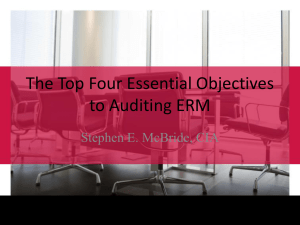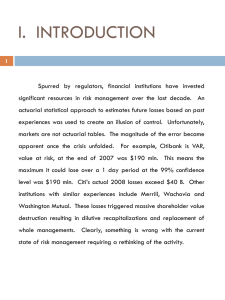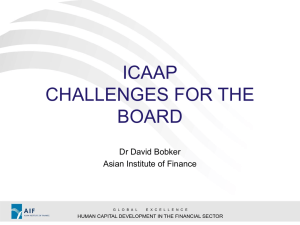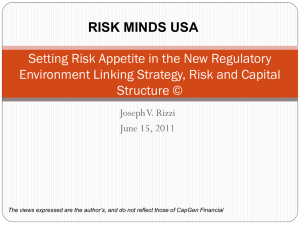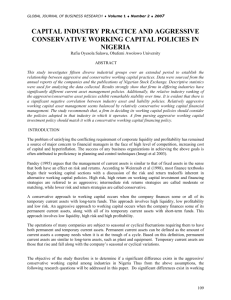Allocating Economic Capital to Drive Business Decisions
advertisement
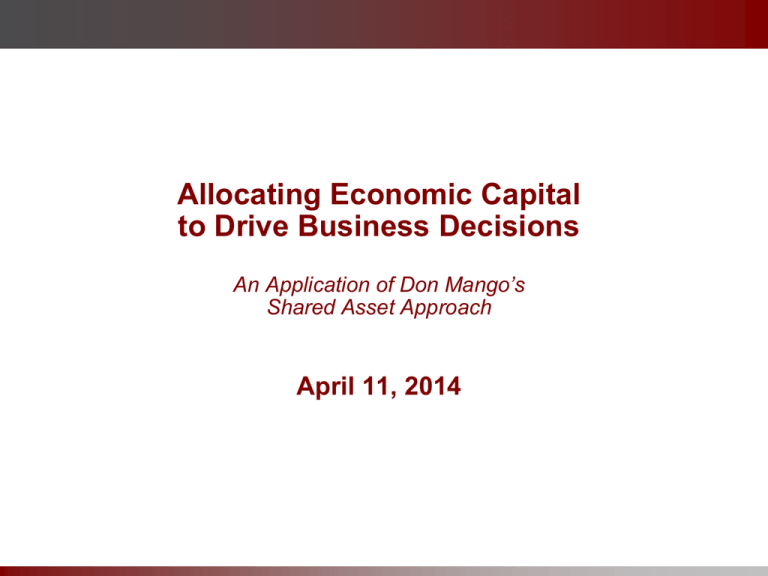
Allocating Economic Capital to Drive Business Decisions An Application of Don Mango’s Shared Asset Approach April 11, 2014 Originally Don Mango’s Portion Why is he not here? • He made a scheduling blunder double-booked with a family commitment • Recognizing this is shorter than our usual session, and that his portion covers material in a published article, he felt his part should be edited down • He wants you to see Tim and Terri! Original paper – 2005 ASTIN Bulletin (reprinted in the 2006 CAS Forum): “Insurance Capital as a Shared Asset” www.casact.org/library/astin/vol35no2/471.pdf One example of presentation: www.casact.org/education/reinsure/2005/handouts/mango.ppt It is the foundational text for the Cost of Capital portion of the Institute of Actuaries (UK) syllabus 2 Shared Asset in Two Slides (#1) Shared Assets • Common pool resources that are shared • Some are used consumptively and some non-consumptively Consumptive (e.g., Reservoir, fisheries) • Instantaneous with no return and no re-use • Think DESTRUCTION Non-consumptive (e.g., golf course, hotel) • Time-based with return and subsequent re-use (with minimal maintenance) • Think RENTAL 3 Shared Asset in Two Slides (#2) In good times, an insurance portfolio only RENTS the capital • “Reserves hold” • If we knew secretly this was a riskless portfolio, this would still represent the “keep the lights on” minimum capital However, when things go badly, the portfolio CONSUMES the capital • “Reserve strengthening” or “catastrophe” • Our capital model gives us the supporting information • We need to define for ourselves just how “at-risk” this portion of the capital is, which lines are the culprits, and who should pay how much This exercise we are calling “Defining our Risk Preferences” 4 Explicit Risk Preferences 5 Every Approach Has an IMPLICIT Risk Preference Risk Aversion VaR VaR CARE!! Don’t Care Size of Loss Don’t Care VaR Threshold 6 Every Approach Has an IMPLICIT Risk Preference Risk Aversion TVaR Additional Care per $ of additional loss is constant Don’t Care Size of Loss CARE VaR Threshold 7 Every Approach Has an IMPLICIT Risk Preference “Zones of Impact” of Capital Risk Aversion Ratings Downgrades Ratings Watch Lost Earnings Don’t Care Size of Loss CARE EVEN MORE CARE MORE CARE Heights of the different boxes represent the firm’s RISK PREFERENCE FUNCTION 8 Articulating Risk Preferences 1. Being audited by the IRS 2. Catching a foul ball at baseball game 3. Being on a plane with a drunken pilot Expected 1-in-100 1-in-200 1-in-500 Using the Shared Asset Framework to allocate capital within a company 10 Allocating capital is an iterative process Risk Model Data Risk Appetite Feedback Loop Results Smart People Doing Math 11 Risk model data Illustrative Company • • • $10B Premium 4 States 2 lines (non-volatile & volatile) Premium Distribution Total Co Earnings Profile 100% 100% 90% 90% 70% 70% 60% 50% 40% LA 10% 60% 50% 40% 30% 30% 20% Line 2 80% MN Percentile 80% Line 1 20% FL 10% MA 0% 0.5 0% 0.0 (0.5) (1.0) (1.5) (2.0) (2.5) (3.0) (3.5) (4.0) (4.5) (5.0) (5.5) (6.0) Underwriting Income ($B) Risk Metrics Risk Type Premium C/R Expected Profit Prob. of Profit Std Dev Profit 1/100 1/250 1/1,000 Line 1 Non-volatile $7B 96.0 $0.3B 94% $0.2B ($0.2B) ($0.2B) ($0.3B) Line 2 Volatile $3B 94.0 $0.2B 83% $0.6B ($1.4B) ($2.6B) ($6.2B) $10B 95.0 $0.5B 93% $0.6B ($1.1B) ($2.3B) ($6.2B) Total Co 12 Risk appetite informs target capital Risk appetite + Shared Asset Framework = target capital Everyone’s appetite is different, let’s examine two choices • Conservative: withstand 2x 1/250 years without losing “secure” rating • Aggressive: withstand 2x 1/100 years without losing “secure” rating Target Capital Line 1 Line 2 Total Co $6.3B Line 1 Line 2 Total Co $4.1B $6B $2.5B $4.7B $3.0B $3.0B $1.4B $1.4B $2.2B $3.3B $2.2B $1.1B $3.3B $2.2B $2.2B $0 $1.1B Conservative Appetite Aggressive Appetite 13 Allocating to state Guiding Principles: • Fundamental before technical • Keep it simple Rental charge applied to states via uniform P/S ratio Consumption charge will vary, but how? • Could use same approach as assigning to line segments (fixed point) • Or, could vary according to contribution to marginal portfolio risk (continuous) $6B Line 2 Target Capital Total Co Earnings Profile $4.1B $3.0B $0 $1.4B Contribution to Marginal Risk $1.1B $1.1B Uniform 2.7 P/S Conservative Appetite Aggressive Appetite Line 2 100% 90% 80% 70% 60% 50% 40% 30% 20% 10% 0% 0.5 0.0 (0.5) (1.0) (1.5) (2.0) (2.5) (3.0) (3.5) (4.0) (4.5) (5.0) (5.5) (6.0) Percentile $2.5B Line 1 Underwriting Income ($B) 14 Contribution to marginal risk Definition of marginal risk? • • Total loss Worse then expected (excess of mean) Total Co Earnings Profile Line 1 Line 2 100% 60% 40% 20% 0% 0.5 0.0 (0.5)(1.0)(1.5)(2.0)(2.5)(3.0)(3.5)(4.0)(4.5)(5.0)(5.5)(6.0) Underwriting Income ($B) Line 2 Loss x/s Mean 100% 90% 80% 70% 60% 50% 40% 30% 20% 10% 0% 0.0 MA FL LA MN Percentile Percentile 80% 0.5 1.0 1.5 2.0 2.5 3.0 3.5 4.0 4.5 Modeled Loss x/s Mean ($B) 5.0 5.5 6.0 6.5 15 Allocation mechanics Some outcomes are worse than others, differentiate consumption charge accordingly Simple Risk Preference Line 2 Loss x/s Mean MA FL LA MN Allocation “Impairment” Conservative 10yr “Earnable” Payback “Impairment” Percentile 100% 90% 80% 70% 60% 50% 40% 30% 20% 10% 0% 0.0 Conservative Allocation $0.5 $0.4 $0.3 $0.2 $0.1 $0.0 Earnable 0% 0.5 1.0 1.5 2.0 2.5 3.0 3.5 4.0 Modeled Loss x/s Mean ($B) 4.5 5.0 5.5 6.0 6.5 Avg Loss X/S Mean ($B) Aggressive Avg Loss X/S Mean ($B) • Losses that you earn your way out of (“earnable”) vs. those you don’t (“impairment”) • Simple math is window average loss (co-x TVaR) Impairment 100% Aggressive Allocation $3.0 $2.0 $1.0 $0.0 Earnable 10% Impairment 90% 16 Results Capital allocation translated into target combined ratio These results are an important feedback loop $0.5 $0.4 $0.3 $0.2 $0.1 $0.0 Conservative 100 Aggressive 97 98 94 95 Earnable 0% Avg Loss X/S Mean ($B) Line 2 Target Combined Ratio Conservative Allocation Impairment 100% Aggressive Allocation $3.0 Combined Ratio Avg Loss X/S Mean ($B) • Risk preferences are hard to articulate • If you can’t accept these results, revisit your risk appetite 90 86 83 $1.0 65 $0.0 60 Earnable 10% Impairment 76 $4.0B Target Capital 81 75 73 70 $2.0 93 87 85 80 $2.6B Target Capital MA NJ FL LA MN Total 90% 17 Driving business decisions with economic capital 18 Risk market in action Target combined ratios are the “price” in our risk market Prices send signals How would you respond to these signals? Line 2 Target Combined Ratio Conservative 100 97 Line 2 Returns Aggressive 98 94 18% 18% 85 80 86 83 76 81 75 73 70 Actual C/R 93 87 Return on Target Capital Combined Ratio 95 90 Conservative Allocation Aggressive Allocation Target Return (10%) 20% 16% 14% 12% 12% 10% 10% 10% 10% 8% 8% 6% 7% 4% 5% 4% 65 2% 60 0% 3% MA FL LA MN Total MA 88 98 95 93 94 ? FL Shrink LA MN Total ? Grow ? 19 The final frontier Managing as a portfolio requires ability to make trades Profit Growth Return Volatility Total Co Efficient Frontier 20% 18% MN 16% LA Return on Target Capital • • • • 14% Total Co 12% MA 10% 8% FL 6% 4% 2% 0% 0% 5% 10% 15% 20% Std Dev of Return on Target Capital 25% 30% 35% 20 Optimizing Diversification has multiple benefits in optimizing portfolio • Can make new risks look good • Can make existing risks look better Risk appetite and current portfolio define possibilities Example: Remove FL Total CoCo Efficient Frontier (Pro Forma) Total Efficient Frontier (Base) 20% Return on Target Capital 18% MN 16% LA 14% Total Co 12% MA 10% 8% X 6% 0% 5% 10% 15% 20% 25% FL 30% 35% Std Dev of Return on Target Capital Target Combined Ratio (Pro Forma) Target Combined Ratio (Base) MA FL LA MN Total MA FL LA MN Total Line 1 100 100 100 100 100 100 - 100 100 100 Line 2 87 73 97 98 94 88 - 98 100 97 Optimizing…Round 2 Example: Increase LA by 50% Total Efficient Frontier (Base) Total CoCo Efficient Frontier (Pro Forma) 20% Return on Target Capital 18% MN 16% LA 14% Total Co 12% MA 10% FL 8% 6% 0% 5% 10% 15% 20% 25% 30% 35% Std Dev of Return on Target Capital Target Combined Ratio (Pro Forma) Target Combined Ratio (Base) MA FL LA MN Total MA FL LA MN Total Line 1 100 100 100 100 100 100 100 100 100 100 Line 2 87 73 97 98 94 88 75 95 98 94 Q&A 23
